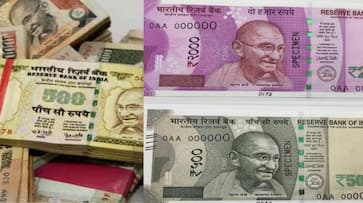The rupee has been free falling owing to various global factors influencing Indian trade and other parameters
New Delhi: The Indian rupee recorded an all-time low on Tuesday in the opening trade against the US dollar after crude oil prices surged to a near four-year high. The currency opened at 72.96 per dollar.
The rupee was trading at 72.95 to a dollar around 9.15am, which is 0.44% down from its Friday’s close of 72.63. This raises concerns as higher oil rates may lead to a fiscal slippage and increase inflationary pressures, which could mean another rate hike by the Reserve Bank of India (RBI) in its October meeting.
The rupee has been witnessing a free fall owing to various global factors influencing Indian trade and other parameters.
So far this year, the rupee has declined 12.2%, while foreign investors have sold $1.11 billion and $6.72 billion in the equity and debt markets respectively.

Crude at a high
Brent crude breached $81 a barrel — its highest level since November 2014 — on the back of a tightening oil market, with OPEC leaders signalling they won’t be able to boost output immediately.
The prices of crude oil have been rising in the world markets primarily due to sanctions on Iran and a major production cut in Venezuela. These two are the key suppliers of crude oil in the world market.
On the whole, India imports almost 80% of its crude oil requirements. Rising crude prices and the recent 10% slide in the rupee has translated into higher fuel prices for consumers.
US influence
The US Federal Reserve’s decision to hike interest rates has put tremendous pressure on the rupee. An increase in the interest rate would make investment in the US more profitable. The Federal Reserve, under president Donald Trump, has adopted inward focus in an attempt to strengthen the US economy.
This has seen investors pulling out money from emerging markets, including India. So when investors stop putting money in emerging markets, it increases demand for the dollar as against the rupee. In recent times, the country has been creating various tariff walls, making investments in local industries and businesses more lucrative.
The US-China trade war and European uncertainty have also contributed to the scenario.
India looking for respite
In a bid to strengthen the rupee and prevent its free fall, the Centre is likely to impose higher import duties on precious stones, certain types of steel and electronics, a finance ministry official said.
The official, who didn't want to be named, said the main reason for the planned increase in duties was to restrict the inflow of items displaced by an escalating US-
China trade tension. The government is also trying to curb imports of 'non-essential' items to support the rupee.
On Monday, S&P Global Ratings said India may opt to control retail fuel prices to cushion inflationary shocks.
Other currencies
Most Asian currencies have been trading lower as American tariffs to the tune of $200 billion on Chinese goods took effect. China has said it won’t hold trade talks until president Trump stops his threats.
The Indonesian rupiah was down 0.28%, Philippines peso 0.19%, Malaysian ringgit 0.1%, China renminbi 0.09%, Thai Baht 0.09%. The Singapore dollar and Japanese yen were down 0.04% each. However, the South Korean won and China offshore were up 0.09% each and Taiwan dollar rose 0.07%.
The dollar index, which measures the US currency’s strength against major currencies, was trading at 94.329, up 0.15% from its previous close of 94.185.
With agency inputs
Last Updated Sep 25, 2018, 3:27 PM IST









![Salman Khan sets stage on fire for Anant Ambani, Radhika Merchant pre-wedding festivities [WATCH] ATG](https://static-gi.asianetnews.com/images/01hr1hh8y86gvb4kbqgnyhc0w0/whatsapp-image-2024-03-03-at-12-24-37-pm_100x60xt.jpg)
![Pregnant Deepika Padukone dances with Ranveer Singh at Anant Ambani, Radhika Merchant pre-wedding bash [WATCH] ATG](https://static-gi.asianetnews.com/images/01hr1ffyd3nzqzgm6ba0k87vr8/whatsapp-image-2024-03-03-at-11-45-35-am_100x60xt.jpg)


